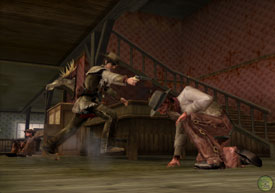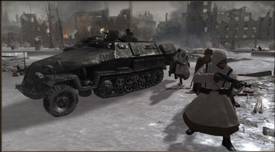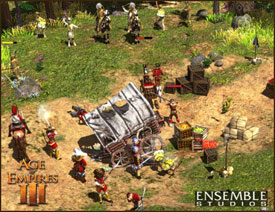 Shoot
‘em Ups and Build ‘em Ups – New Games Offer Great
Diversions
Shoot
‘em Ups and Build ‘em Ups – New Games Offer Great
Diversions
By Jim Bray
Gun
Call of Duty 2
Age of Empires III
Computer games continue to evolve and to offer hours of excitement
for those who want to live other lives vicariously.
I’ve been playing with three of the newest releases, and
though I don’t have enough time (or, alas, skill!) to do them
justice, I’ve certainly had a lot of fun living in the old
West, on the battlefields of World War II, and building my own empire
while dumping on others. The games, Gun, Call of Duty 2 and Age
of Empires III respectively, come from Activision and Microsoft
and are definitely diverting.
Continued....
 ...continued
...continued
Gun
Gun gives you the starring role in a Western adventure. Set in
the late-1800s, GUN isn’t a first person shooter but rather
lets you control the lead character (Colton White) through an action-adventure
scenario where “greed, lust and murder are rampant.”
Shortly after the movie’s, er, game’s opening, you’re
off to help your Pa deal with some lowlifes aboard a riverboat.
You don’t really know why, but the fact that you’re
helping your Paw is enough.
Then he’s shot, but before he dies he lays on you the fact
that he isn’t really your Pa, and sends you off on a mission
to, well, the mission seems convoluted and complex and can change
somewhat through various side missions as you go. But it’s
neat, to say the least.
Along the way, you have to learn to hunt and shoot, to ride a horse,
to shoot from horseback, and various other tests of your mettle
come fast and furious as you walk the fine line between good and
evil to take on corrupt lawmen, a homicidal preacher, renegade soldiers,
nasty outlaws and extremely politically incorrect Native Americans.
Activision and Neversoft have created a beautifully rendered, though
vicious and violent world. Your journeys will take you through countryside
ranging from the snow covered mountains of Big Sky Country Montana,
to the plains of Dodge City and the New Mexico desert. You’ll
hunt game – and people – shoot fire arrows out of the
sky, and stay alive in a land where the law may not necessarily
be applied blindly.
The game is structured to teach you its various aspects, such as
zooming your gun sight for better aim and “quick draw”
mode, as part of the game rather than just as dry tutorials, and
though these segments do slow down the story line I found myself
glad I had to go through them because otherwise I’d have died
a lot more quickly and more often! Not that I didn’t anyway….
Written by the Mask of Zorro’s writer, Randall Jahnson, Gun
sends you through a series of adventures that give you the opportunity
to hold up banks, collect bounties on prisoners, and take over trains.
You have to protect coolies from Indian attack, rescue maidens (well,
maybe not maidens, exactly) in distress, and generally leave your
mark on the old West.
By embarking on various side missions along the way you can earn
money to help finance your life and your inventory, as well as learning
or honing your skills to help ensure you survive. Side missions
include a Texas Hold ‘em poker tournament, hunting for food
with your bow, or earning a living and getting more comfortable
on horseback by working on a local ranch. You can also take a job
with the Pony Express.
In typical game tradition, you can see monitor your character’s
health level and if you’re about to shuffle off the mortal
coil you can refresh by taking a drink from your flask of healing
liquid (I think it’s really whisky). One drink brings you
back up to 100% “ready for action,” assuming you have
any of the stuff left, and of course you can pick up extra flasks
along the way.
The creators have done a nice job of weaving the storyline through
the game action, and as mentioned above, even the “learning”
sections are written into the scenario. And it’s kind of neat
to play (or at least control) the lead character in a good old fashioned
horse opera, just like playing Cowboys and Indians when I was a
kid.
Graphics are very good, as is the audio.
Our version was for PC, but Gun is also available for PlayStation
2, Xbox, Xbox360 and Nintendo GameCube.
 Call
of Duty 2
Call
of Duty 2
Then there’s Call of Duty 2, the sequel to 2003’s first
person shooter. From what I understand, it basically picks up where
the original version (which I never played) left off, adding more
missions to the same basic scenario.
You are fighting the Axis powers here, as a Russian, British or
American soldier in the thick of the action. The online version
lets you become the bad guys, but I didn’t go online; as a
casual gamer, I’ve learned that playing multiplayer means
I spend a lot more time dead than alive, thanks to a lack of skill
when compared with the serious gamers I always seem to run into.
And they’re merciless.
Call of Duty 2 starts you out as a Russian soldier defending the
homeland from the Nazi invasion. The first part is a bit of a weapons
training session where you, as a new recruit are brought up to speed
so you can take your place helping to defend mother Russia.
Before long, you’re in the thick of it, and all Hell is breaking
loose around you! Get through this, and you’ll have unlocked
the British campaign, which follows the Brits as they go after Rommel’s
forces in Africa. It isn’t that the Russian campaign is over,
because you can go back later if you choose, but it’s also
nice to have a change of venue after the intense action.
The game reminds me of a “virtual” version of those
paintball “capture the flag” games, and also of the
times many years ago when we used to play silly bugger in the army
militia – except that we used blanks whereas in COD2 you’re
bound to get your bum shot off if you don’t stay low.
On the other hand, if you stay low all the time you aren’t
going to get anywhere, and you have tasks you need to accomplish.
I found it paid to be aggressive (especially since you come back
to life if you’re killed – and I was killed a lot! –
and the game saves automatically as you progress, which means you
don’t get bogged down excessively).
The missions offer you a wide variety of adventures, from sniping
at hidden Nazis to driving tanks, cleaning out machine gun nests,
and the like. The action is first rate, the graphics realistic and
the aspect ratio appears to work for both 4x3 and 16x9 screens.
 Besides
various pieces of ordnance from pistols to bazookas, you can also
lob grenades – either to obscure the environment with smoke
or to blow your enemies to smithereens. Right clicking on the mouse
of the PC version raises your weapon to eye level for more accuracy
(as opposed to merely running along and firing from the waist),
but slows down your progress across the landscape as you concentration
is taken up by your weaponry.
Besides
various pieces of ordnance from pistols to bazookas, you can also
lob grenades – either to obscure the environment with smoke
or to blow your enemies to smithereens. Right clicking on the mouse
of the PC version raises your weapon to eye level for more accuracy
(as opposed to merely running along and firing from the waist),
but slows down your progress across the landscape as you concentration
is taken up by your weaponry.
I must mention the audio, which is very good so far as sound quality
is concerned. But it’s also worth mentioning for the “thwacks”
of the rounds going off around you, and for the taunting of the
enemy as they try to suck you into thinking they won’t hurt
you if only you choose to be pacific.
Call of Duty 2 was developed by Infinity Ward, who created the
award-winning original. Activision says enhancements include a new
game engine and AI, and choice-based gameplay. Activision means
that you can choose which mission you want to undertake, to a point.
I ran into a different type of choice-based scenario by getting
lost in the desert and, while trying to find my way back to the
mission, I kept getting harangued that I was going the wrong way.
Fortunately, there was no virtual NCO along to kick my butt at the
same time….
The graphics are quite lovely, if such a term can be used to describe
the horrors of war. But it’s beautifully rendered, including
weather effects and, of course, the inevitable gore.
Naturally, there’s an online multiplayer mode here as well.
What a great way to relieve your frustrations after a particularly
rough day at work!
 Age
of Empires III
Age
of Empires III
First person shooters such as Call of Duty 2 are my favorite type
of computer game, followed closely by the “real time strategy”
game, of which Microsoft’s new Age of Empires III is a pretty
good example.
AOE III puts you in the era of around 1500–1850 AD. You control
one of a number of European powers exploring, colonizing and conquering
the Americas. I’m not sure it’s the best game in the
series, or the best RTS game for that matter, but it’s very
good and the graphics are very good as well.
The game builds upon the tried-and-true formula of earlier versions
and other RTS games. But it adds a "home city" concept
that brings long-term “strategery” that lasts from game
to game.
Released by Microsoft, the game is from Ensemble Studios and advances
the series’ timeline into the not-so-distant past compared
with earlier versions. So instead of swordsmen and catapults you
now get musketeers and cannons, etc. Other than that, and some other
tweaks it’s basically the same game, so those who enjoyed
the originals will probably like this one, too.
The game features some really nice visuals, though on my system
I found there were some strange artifacts that could conceal parts
of the ground at times (this could be my system, however, which
isn’t set up for optimum gaming).
The action of the game itself – for example the battles and
the like – doesn’t seem a lot different from other RTS
games, which isn’t a bad thing. But the animation of the characters
and pieces, which you can zoom in quite close to, looks very good,
indeed. Zoom in to watch ships firing broadsides or soldiers having
at each other and you’ll see what I mean.
You can choose from eight different European civilizations, and
you can ally with native tribes. You can play as part of a team
or work on your own to wreak mayhem on the world around you.
Several play modes are available, and single-player mode offers
choices of campaign or skirmish settings. A scenario editor lets
you create your own maps and campaigns
 The
game sees you in charge of a new colony somewhere in the New World
(you can choose from a variety of maps), and your job is to deploy
workers from your town center, to build new structures or harvest
the game's resources of food, wood, and coin. This time around there’s
no stone resource and your citizens no longer have to trudge back
to your town center to drop off resources – they seem to just
work away and your tally increases as they work. This helps to speed
things up.
The
game sees you in charge of a new colony somewhere in the New World
(you can choose from a variety of maps), and your job is to deploy
workers from your town center, to build new structures or harvest
the game's resources of food, wood, and coin. This time around there’s
no stone resource and your citizens no longer have to trudge back
to your town center to drop off resources – they seem to just
work away and your tally increases as they work. This helps to speed
things up.
Your citizen workers can also fight enemies, though of course they
aren’t as good as the various types of soldiers you can also
create.
A nice touch is that military units can be queued up five at a
time, so instead of having to produce them individually, and have
the existing ones wait around for the rest, you can build a group
as long as you have the required resources. It appears to take the
same amount of time to “train” one soldier as five,
which is nice, though of course you can only build your army as
fast as your resource base can support it.
When you’re attacking buildings in AOE III you can take delight
in watching as parts of them are blown to bits before the last chunks
of rubble crash to the ground.
Now, on to the “Home City” feature, which I found quite
confusing – though convenient. It’s here that you get
access to an increasing amount of “shipment” (food,
wood, etc.) options. They appear as “cards” and as your
home city gains in experience you can partake of more powerful cards.
A new character, kind of, is the explorer, a guy who can’t
be killed (at least permanently) and who you can send out to dispel
the fog of war that hides the game field from you at the beginning.
You can also use him to build trading posts and collect treasures.
There are no wonders to build in this version (mayhem and conquest
appearing to be the prime goals of the game!) – and some of
the other forces I’ve fought have tried to wuss out and surrender
before I’d destroyed them to the man.
Didn’t work, though! Nope, they were scoured from the face
of the earth anyway. It was great practice for when I’m emperor
of the planet in real life.
All three of these games are a lot of fun, and I wish I had more
time to waste on them. As it is, to get enough of a feel for the
games I have to put them on the easiest setting (well, I played
Call of Duty 2 on the second easiest after some practice) and it
still takes hours and hours of otherwise productive time to get
a sense for how they feel.
Which, of course, adds to their value.
Jim Bray's technology columns are distributed by the
TechnoFILE Syndicate. Copyright Jim Bray.
Tell us at TechnoFile what YOU think


 Shoot
‘em Ups and Build ‘em Ups – New Games Offer Great
Diversions
Shoot
‘em Ups and Build ‘em Ups – New Games Offer Great
Diversions  ...continued
...continued Call
of Duty 2
Call
of Duty 2 Besides
various pieces of ordnance from pistols to bazookas, you can also
lob grenades – either to obscure the environment with smoke
or to blow your enemies to smithereens. Right clicking on the mouse
of the PC version raises your weapon to eye level for more accuracy
(as opposed to merely running along and firing from the waist),
but slows down your progress across the landscape as you concentration
is taken up by your weaponry.
Besides
various pieces of ordnance from pistols to bazookas, you can also
lob grenades – either to obscure the environment with smoke
or to blow your enemies to smithereens. Right clicking on the mouse
of the PC version raises your weapon to eye level for more accuracy
(as opposed to merely running along and firing from the waist),
but slows down your progress across the landscape as you concentration
is taken up by your weaponry. Age
of Empires III
Age
of Empires III The
game sees you in charge of a new colony somewhere in the New World
(you can choose from a variety of maps), and your job is to deploy
workers from your town center, to build new structures or harvest
the game's resources of food, wood, and coin. This time around there’s
no stone resource and your citizens no longer have to trudge back
to your town center to drop off resources – they seem to just
work away and your tally increases as they work. This helps to speed
things up.
The
game sees you in charge of a new colony somewhere in the New World
(you can choose from a variety of maps), and your job is to deploy
workers from your town center, to build new structures or harvest
the game's resources of food, wood, and coin. This time around there’s
no stone resource and your citizens no longer have to trudge back
to your town center to drop off resources – they seem to just
work away and your tally increases as they work. This helps to speed
things up.